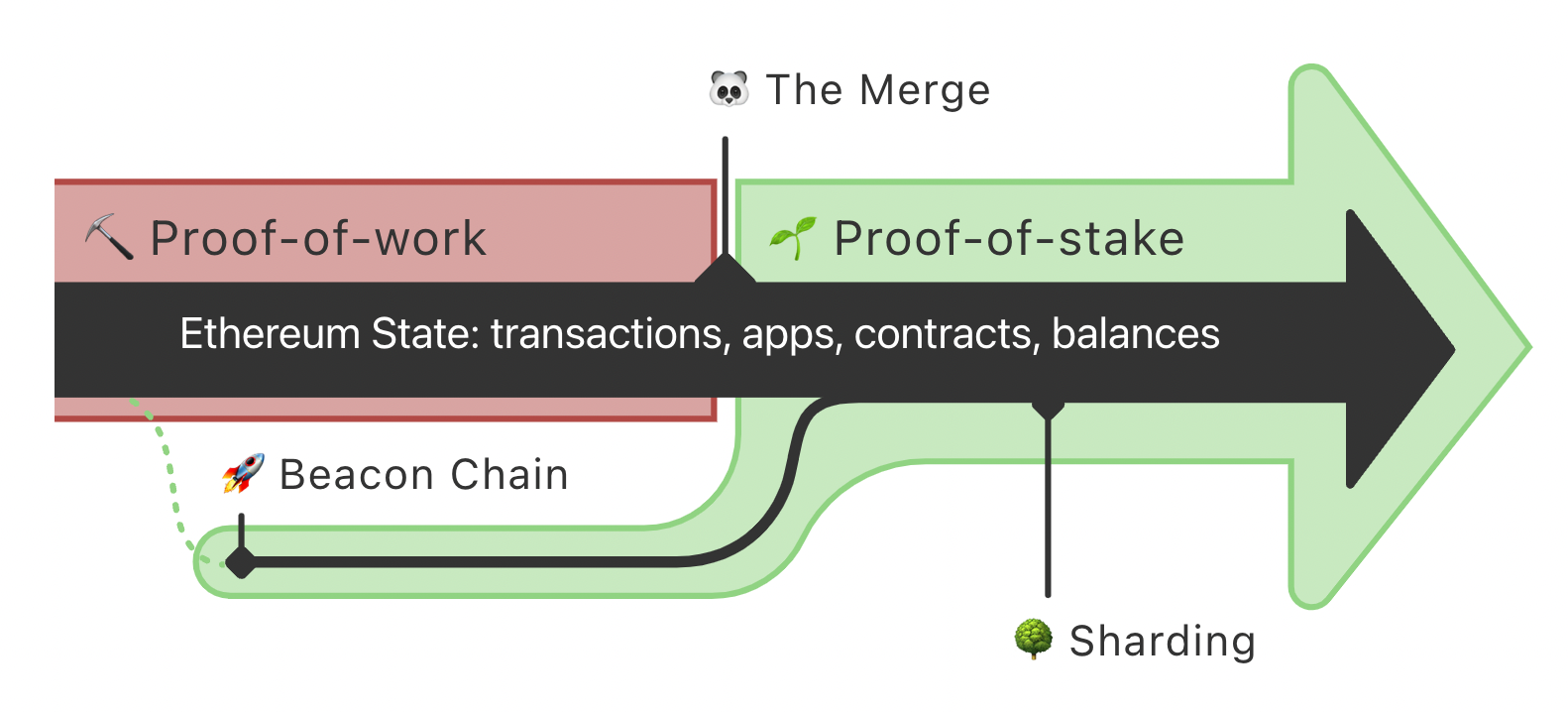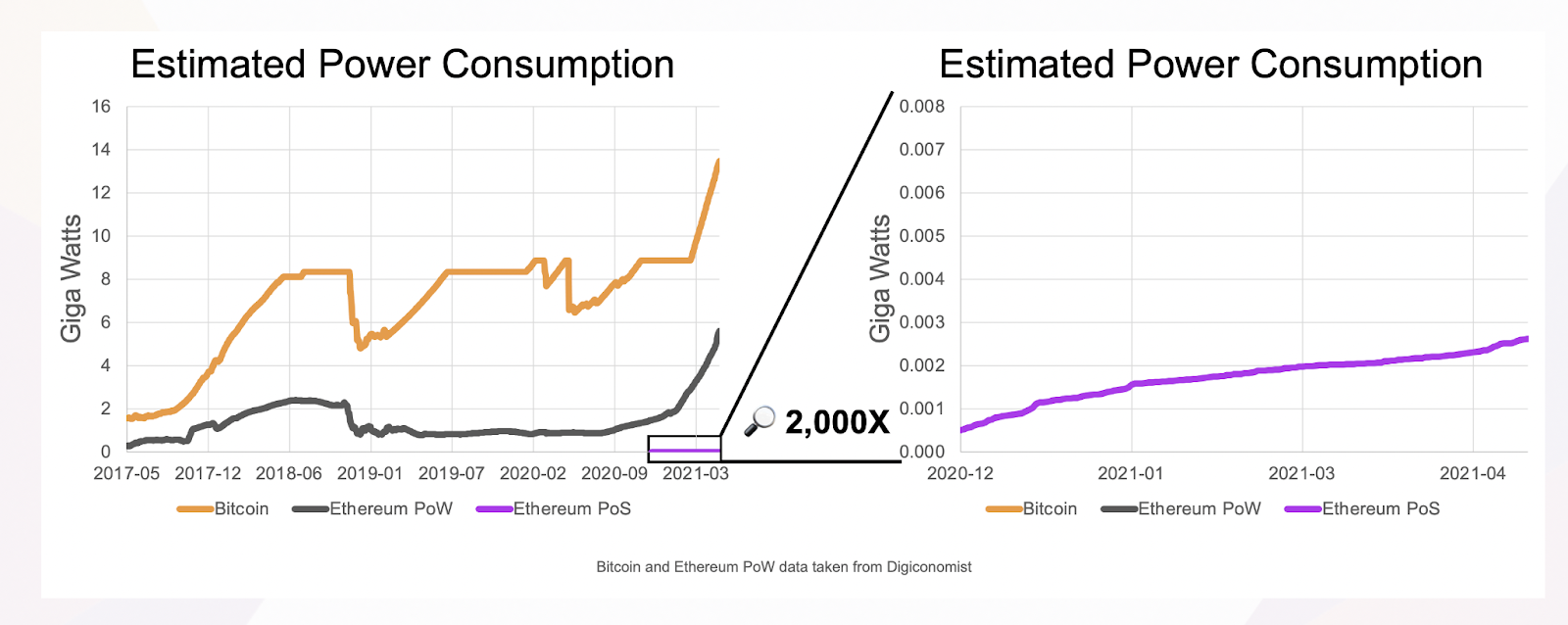
The Ethereum Mainnet Merge, which is just around the corner, is probably the most anticipated event in Ethereum’s history and not without reason since it would represent a massive shift in terms of the fundamentals of how Ethereum operates. It also sets the stage for the next set of upgrades that pave the way for the platform to be used by millions and billions of users.
We would try to understand what the Merge is and explore various aspects around it, including what needs to be done, things to be aware of and what happens if things don’t go as per the plans.
What is the Merge?
In a single line – the Merge will make Ethereum switch from the current Proof-of-work consensus model to a less energy consuming Proof-of-Stake model. The Beacon Chain, which is the Ethereum PoS chain, was running independently of the main Ethereum chain while it was being tested and nodes were participating in securing the network. The Beacon Chain went live on December 1st, 2020.
During the Merge, the Beacon chain would take over the block consensus responsibilities of the main chain. For more info on Consensus Mechanisms, check out this article -
The existing Proof-of-Work nodes would no longer be able to generate nodes for the mainnet to consume. Also, the state of the Ethereum network with all its history of transactions and balances would continue to be preserved with the Merge.

The Proof-of-Stake model determines which nodes generate the next block in proportion to the amount that the nodes have staked in the system. Currently, the staked Eth for the PoS version stands at ~13.3 million Eth valued at close to 20 billion USD.
The new consensus mechanism is a significant departure from the current Proof-of-Work mechanism where the computational resources determine the node that is more likely to generate the next block.
This leads to significant energy savings as heavy computations are no longer required to secure the network. The Proof-of-Stake model is around 2000 times more energy efficient that PoW and it would result in 99.95% less energy consumed.

How does the Merge impact things?
The Merge event will impact the Ethereum ecosystem in multiple ways. We already looked at the energy impact from the switch to PoS with the Merge. Let us look at some other aspects – Transaction Speed, Fees, Security of the system, etc.
Gas Fees – As much as we would like it to reduce the transaction gas fees, the Merge is not going to have a significant impact on that. This would continue to be determined by network congestion factors to keep it functioning.
Transaction Speed – The transaction speeds also would not be significantly impacted due to the Merge. In the current PoW system, blocks were generated at roughly every 13.2 seconds. In PoS post-Merge, a block will be generated every 12 seconds (with few drops here and there). Although the blocks would be generated faster, it would not result in any noticeable differences.
Security – The security of the network would also be improved with the Merge. It would still be susceptible to 51% attacks just that instead of computing power it would have to be staked Ethereum tokens. This is a really risky move for a participant who would have managed to secure such a high number of tokens. Additionally, with the consensus model changes, the finality of the blocks are also going to be achieved faster making it difficult for any unwanted/unplanned forks.
**Deflationary – **In the PoS system, there would be no additional block rewards for the validators except the transaction fees that are set by the users. This would reduce new Eth issuance and make the system consistently deflationary due to existing burning of tokens. The overall issuance of ether is predicted to be reduced by 4.2% a year. This would be good news for its long-term value.
How to prepare for the Merge?
For end-users and holders – You are not required to do any additional steps before or after the merge if you are a user or you have funds in your Ethereum wallet or in any exchange. Your funds would be absolutely safe and accessible post the Merge.
Some exchanges have announced a temporary maintenance period during the Merge where deposits/withdrawals and/or trading may be suspended. Do take some time to go through any communication from your exchanges in this regard.
After the Merge, there would be no new tokens created so do not pay heed to any such social media posts requesting to take action to get new Eth or Eth2 tokens. These would mostly be scamsters trying to siphon off funds from gullible users.
For developers – If you are developing a dapp or already have a dapp deployed on the Ethereum mainnet you may want to go through the changes so ensure if your application is impacted. There are some changes in the block structure and Opcodes that are used. Also, the Goerli testnet should be considered as the primary testnet for testing dapps before deploying on the mainnet since it has executed the PoS merge successfully and is up to date. Ethereum Foundation has also come up with a post outlining the impact at the application layer that would be a good starting point to understand the impact –
For node operators – For validators running a node, they would have to run both the consensus layer client and the execution layer client. Also, certain configurations need to be set up before the nodes are considered online. There is a detailed guide for the Merge readiness provided by Ethereum foundation that can be accessed here –
When is the Merge going to happen?
The Merge is supposed to be executed on the Mainnet around September 13/14, 2022. A real time countdown can be found at –
The Merge will be based on the concept of Terminal Total Difficulty of producing blocks and not at a specified block number (which has been the standard approach of executing updates on the Ethereum network)
What happens if the Merge doesn’t go as planned
Ethereum had pushed out the date of the merge a few times earlier but this time all preparatory steps around the Merge have been completed without any major hiccups. The latest step in this process was the PoS merge of the Goerli testnet that was successfully completed on the 11th of August.
There seem to be less chances of any issues arising during the mainnet Merge but any unlikely event would be bad news for the ecosystem and could lead to a major sell-off. Also, it would mean delayed withdrawal opportunities for those who have already staked Ethereum on the Beacon Chain.
There is a strong possibility that even in the event of a successful Merge, there may be a hard fork of the mainnet that would continue to be backed by PoW consensus. In that case, there would be an official Proof-of-Stake version and an alternative Proof-of-Work version. It would all depend on what is the market acceptability of the PoW hard fork.
Coinbase has announced that it would evaluate all potential PoW forks post the Merge. Some others have already announced their support for the official PoS version.
What’s next after the Merge?
After the merge, the next major upgrade for Ethereum would be the Shanghai upgrade. This would enable withdrawals of the staked Eth on the network. That, automatically means that even right after the Merge, staked Eth withdrawals won’t be enabled. Also, keeping in mind the security considerations, post the Shanghai upgrade, the withdrawals would be rate limited so that there is no avalanche of withdrawals.
As mentioned earlier, the Merge would lay the foundation for further upgrades to the network that would address the scalability concerns. There would be sharding of the network that is planned that would lead to multiple sub-chains of the network that are co-ordinated. Along with that there has been some significant work done on L2 rollups that would bundle multiple transactions and then post it on the primary Ethereum network for improved security. This would increase the scale manifold as well as reduce the transaction costs. There are multiple L2 rollup projects that are in operation today that are continuously optimizing on the data size requirements for storing bundled transaction data on the Ethereum network.
Further Reading
If you are curious to know more about the Beacon Chain, the Merge, Ethereum Fundamentals, the following resources could be helpful –
[https://ethereum.org/en/upgrades/merge/#what-is-the-merge
](https://ethereum.org/en/upgrades/merge/#what-is-the-merge
)
[https://www.alchemy.com/the-merge
](https://www.alchemy.com/the-merge
)
[https://blog.ethereum.org/2021/05/18/country-power-no-more
](https://blog.ethereum.org/2021/05/18/country-power-no-more
)
)